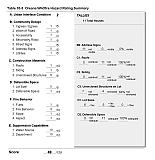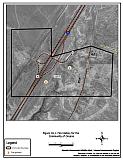10.0 Oreana
10.1 Hazard and Risk Assessment
Oreana is located in central Pershing County adjacent to Interstate 80, north of Lovelock (see Figure 10-1). Oreana was originally established as a railroad siding. There are currently 11 residential homes in Oreana, located primarily on the east side of Interstate 80. There are some commercial buildings on the west side of Interstate 80 near the railroad tracks. The risk and hazard assessment resulted in classifying Oreana in the Moderate Hazard category (49 points). The primary hazard factors are the lack of a community water system and local fire suppression resources. The community assessment summary sheet is provided at the end of this section.
10.1.1 Community Design
Oreana is classified as an intermixed interface condition. Structures are scattered throughout the wildland area with no clear line of demarcation between wildland fuels along roads and back property fences and structures. Lot sizes vary from less than one acre to ten acres in size. Structure spacing is generally close together, with one structure surrounded by a sizeable expanse of vacant land.
- Roads: Interstate 80 is the major transportation route through Oreana. Interstate 80 is a paved four lane divided highway.
Old US Highway 40 runs through the community on the east side of Interstate 80. Other secondary roads in the community are unpaved but well graded. All roads provide adequate room for fire equipment to maneuver.
- Signage: Street signs are present and visible along most of the streets. Residential addresses were not visible on any of the homes surveyed. However, the community is small and all homes are easily visible from the single access road into the community. There would be little chance of fire suppression personnel being unable to locate a particular structure that needed protection. However, evacuation of persons needing assistance at a particular address would be difficult for emergency responders unfamiliar with the area.
- Utilities: Electric utilities are all above ground. There is minimal vegetation in the power line corridors, minimizing the ignition risk from sparking power lines during windstorms.
10.1.2 Construction Materials
Approximately two-thirds of the homes in the interface are built with combustible siding materials. Many of these homes have medium-density fiberboard (MDF) siding that will burn when exposed to high temperatures for a prolonged period of time. The minimal fuel load adjacent to most of these homes reduces the hazard that this combustible siding presents.
All of the homes have fire resistant roof materials such as composition roofing or metal. Over half of the homes observed had unenclosed balconies, porches, decks or other architectural features that could create drafts and provide areas where sparks and embers can smolder and rapidly spread fire if the home ignites.
10.1.3 Defensible Space
All of the homes have landscaping that would meet the minimum defensible space requirement to help protect the home from damage or loss during a wildfire.
10.1.4 Suppression Capabilities
Wildfire Protection Resources
There is no organized volunteer or paid fire department in Oreana. The community relies on the volunteer fire departments in Lovelock and Rye Patch in the event of a wildland fire.
Table 10-1 lists the types of wildfire resources, cooperating partners and equipment available to Oreana in the event of a reported wildland fire.
| Response Time |
Type of Equipment | Amount | Cooperating Partner (Resource Location) |
|---|---|---|---|
| 10- 30 minutes | Engine Water Tender Command Vehicle |
1 1 1 |
Lovelock VFD (Lovelock) |
| 1- 2 hours | Engine | 1 | Rye Patch VFD (Rye Patch) |
| Source: Chief Chuck Rasco, pers. comm., Feb. 9, 2004. | |||
The initial response to a wildland fire by volunteer-staffed fire departments will vary depending on day of week and time of day that the fire is reported. Some volunteer fire department members may be unable to respond immediately to fire calls during normal working hours.
Water Sources and Infrastructure
There is no community water system in Oreana.
Fire Protection Personnel Qualifications
Not Applicable.
Work Load
Not applicable
Financial Support
Not applicable.
Community Preparedness
Pershing County has an active Local Emergency Planning Committee and has adopted an all-risk, multi-agency emergency plan. The plan is periodically updated and was last revised in 2003.
10.1.5 Factors Affecting Fire Behavior
The vegetative fuel density in the Oreana interface area is classified as light. Fuels in the community on the east side of Interstate 80 consist primarily of fourwing saltbush, shadscale, and cheatgrass. There is also big sagebrush, rabbitbrush, Great Basin wild rye, and cheatgrass along the road shoulders. The fuel density is estimated to be less than one ton per acre.
Fuels in the community on the west side of Interstate 80 consist primarily of cheatgrass as a result of a previous wildfire. There is also rabbitbrush and Russian thistle along the road shoulders. The fuel density is estimated to be less than one-half ton per acre.
The winds are predominantly out the west/southwest in the later afternoons. The terrain is typically flat with little to no slope.
10.1.6 Fire Behavior Worst-Case Scenario
The worst-case scenario for the community of Oreana would begin with an ignition south or southwest of the community on a summer afternoon. Winds from the south or southwest would drive the fire into the community. The lack of local fire suppression resources and the proximity of the nearest fire department could result in significant loss of property before the first fire resources arrive.
10.1.7 Risk Assessment
Oreana has been assessed as having a low ignition risk. Nevertheless, the old wooden structures in the community and the expected response times for firefighting equipment increase the hazard that a wildfire would pose to the community
The following factors pose the greatest hazard for ignition sources that could start a wildland fire:
- Lightning
- Railroad
- Debris Burning
- Burn Barrels
- Utility Corridors
- Children with Matches
- Fireworks
10.2 Risk and Hazard Reduction Recommendations, Roles, and Responsibilities
Oreana is a small community with no local fire suppression resources and no community water system. The Oreana Risk/Hazard Reduction Recommendations focus on maintaining the established defensible space. Other recommendations pertain to homeowners aiming to enhance fire safety in Oreana. The recommendations are detailed below and summarized in Table 10-2.
10.2.1 Defensible Space Treatments
General guidelines for improving defensible space around residences and other structures in the community are described below.
Property Owner Responsibilities
- Remove, reduce, and replace vegetation around homes according to the guidelines in Appendix D. This area should be kept:
- Lean: There are only small amounts of flammable vegetation,
- Clean: There is no accumulation of dead vegetation or other flammable debris,
- Green: Existing plants are healthy and green during the fire season.
- Maintain this defensible space as needed to keep the space lean, clean, and green.
- Where cheatgrass has become dominant within the defensible space area it should be mowed prior to seed set, or an application of a pre-emergent herbicide can be used. Mowing may need to be repeated the following year to ensure that the seed bank of unwanted grasses has been depleted. Refer to Appendix I for approved seed mixes and planting guidelines than can be used in conjunction with removal of this annual grass.
- Maintain areas under wood decks and porches free of weeds and other flammable debris.
- Move old woodpiles and firewood away from structures a minimum distance of 30 feet.
10.2.2 Fuel Reduction Treatments
Fuel reduction in strategic areas or replacement of those materials with less flammable fuels will help protect structures and other resources. The following recommendations will provide added protection to structures in the community and also allow safe routes for fire suppression equipment in the event of a wildland fire.
Nevada Department of Transportation and Pershing County
- Mow vegetation along road shoulders a minimum width of 10 feet from the edge of roadways and the Interstate 80 frontage road. Remove excess biomass to a suitable disposal site.
10.2.3 Community Coordination
Coordination among local, state and federal fire suppression agencies is important in day-to-day fire prevention activities and becomes critical in the event of a wildland fire. During a fire event, firefighters from other communities and states may be dispatched to work in unfamiliar areas. Coordination becomes more important in communities such as Oreana where there is no local fire suppression agency. The following recommendations related to Community Coordination should be implemented in Oreana:
Property Owner Responsibilities
- Form a local chapter of the Nevada Fire Safe Council. The Nevada Fire Safe Council has the purpose of working on solutions to reduce the loss of lives and property from the threat of fire in Nevada’s communities. Through the establishment of a local Chapter, local communities will have access to the information network that receives notifications of programs and funding opportunities for fire mitigation projects such as those listed in this report and will become part of a large network for sharing information. The Nevada Fire Safe Council will accept and manage grants and contracts on the Chapter’s behalf through its non-profit status. The Nevada Fire Safe Council will provide assistance and support to communities to complete fire safe plans, set priorities, educate and train community members and promote success stories of its members. To form a local Chapter or for more information, contact the Nevada Fire Safe Council, PO Box 2724, Carson City, NV 89702, telephone (775) 884-4455.
Pershing County Responsibilities
- Allow burning only under a permit process or on designated community burn days. See Appendix G for a sample burn permit.
10.2.4 Public Education
Public education regarding how to become more fire safe is critical in communities that have no local fire suppression resources such as Oreana.
Pershing County Responsibilities
- Distribute copies of the publication “Living with Fire” to all property owners. This publication is free of charge. Copies can be requested from the University of Nevada Cooperative Extension, (775) 784-4848.
10.3 Summary of Recommendations
| Responsible Party |
recommendation Description |
|---|---|
| Property Owners | Remove, reduce, and replace vegetation around homes according to the guidelines in Appendix D. Maintain defensible space Remove cheatgrass from defensible space. Keep annual grasses and weeds from growing and accumulating under wood decks and porches. Move old woodpiles and firewood away from structures. Form a local chapter of the Nevada Fire Safe Council |
| NDOT | Mow vegetation along road shoulders a minimum distance of 10 feet from the edge of roadways. Remove excess biomass. |
| Pershing County | Allow burning only under a permit process or on designated community burn days. County should distribute copies of the publication “Living with Fire” to all property owners. |
Table 10-3Oreana Wildfire Risk/Hazard Assessment Summary Sheet |
 |
Figure 10-1Fire History for the Community of Oreana |
 |
